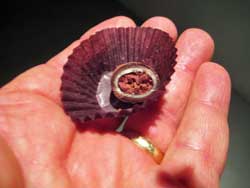Video: Texas Port-Style and Dessert Wines – The Perfect Ending but Possibly Much More
In the sixth and final Texas wine webcast, Merrill Bonarrigo of the Messina Hof Winery in Bryan, Texas, discusses Port, a variety native to Portugal, as well as other dessert wines that are thriving in Texas. She tastes Lenoir (Black Spanish) Port-style wine, and discusses late harvest Riesling, Muscat Canelli, and even a Texas Madeira, only one of three made in the United States.
It is my experience that people have an increasing penchant for sweetness these days. Many wine magazines now hype “Semi-Dry” as the “New Dry”. Why is this? Well, many folks came from a generation that started the day with a good cup of strong coffee and a newspaper. But, nowadays, it is not unusual for some to have a diet Coke or other caffeinated soft drink with their morning email. Sweetness has permeated our existence, whether in the sauce, drink or dessert.
 Many premium wine regions have something in common with Texas. If truth be told, they actually have a sweet streak. These regions include Riveraltes and Banyuls in the French Rhone, Jerez in Spain, Duoro in Portugal. Even Chianti and points south in Italy have their almondy Vin Santo wine, and the islands of Madeira coalesce sunlight with balmy breezes to create ripe grapes that produce their sweet concentrated nectars. Also, let’s not forget the most noteworthy of all sweet wines, French Sauternes and Tokaji Aszú, the wine of kings (and the king of wines) from Hungary.
Many premium wine regions have something in common with Texas. If truth be told, they actually have a sweet streak. These regions include Riveraltes and Banyuls in the French Rhone, Jerez in Spain, Duoro in Portugal. Even Chianti and points south in Italy have their almondy Vin Santo wine, and the islands of Madeira coalesce sunlight with balmy breezes to create ripe grapes that produce their sweet concentrated nectars. Also, let’s not forget the most noteworthy of all sweet wines, French Sauternes and Tokaji Aszú, the wine of kings (and the king of wines) from Hungary.
We normally think of premium wines in esoteric terms that extol the virtues of their dryness, complexity and finesse. But, we forget that, in many cases, the most sought after wines from these regions that actually attract the highest prices, are not their dry table wines, but sweet late harvest, dessert and fortified wines.
The hardest part of making pleasing sweet wines is getting the balance of sweetness and acidity correct. Sweet wines should stimulate all parts of the tongue with sweetness along with a balancing acid that keeps the flavor clean and fresh, sip after sip.
 Many believe that the Texas sweet tooth comes from our relative inexperience with wine. People often commence their wine experience by drinking wines made with a small percentage of residual sugar. These quaffable, fun wines provide good company to fun foods such as B-B-Q, burgers, pizza, and, oh yes, my favorite….spicy hot wings. However, if made properly with a good balance of sweetness and acidity, these wines can be both pleasurable and amazingly versatile in food pairing.
Many believe that the Texas sweet tooth comes from our relative inexperience with wine. People often commence their wine experience by drinking wines made with a small percentage of residual sugar. These quaffable, fun wines provide good company to fun foods such as B-B-Q, burgers, pizza, and, oh yes, my favorite….spicy hot wings. However, if made properly with a good balance of sweetness and acidity, these wines can be both pleasurable and amazingly versatile in food pairing.
The allure of sweet wines to Texans may also be due to long standing cultural traditions in the style of homemade wines. They were commonly made from Texas Mustang or Muscadine grapes or local fruit wines available to ‘Grampa’. These wines were typically sweet. Some wine drinkers are simply searching for a wine that matches the taste with which they grew up.
Two sweet white wines that many people enjoy are made from Texas-grown Muscat and Late Harvest Riesling. In fact, one chef that I knew that had a daring interest in Texas wines suggested that the Riesling would pair equally well with either spicy Indian food or alternatively with peach or plum tarts. Even more interesting was his recommendation for the Muscat was to have it accompany foie gras or lobster, or with a more conventional dinner finale consisting of Middle Eastern desserts.
Bold fortified wines from Texas include Ruby Port and Cream Sherry. The aromas of caramelized sugar and honey in the Sherry suggest pairings with pound cake, scones, or almond desserts, but it would work well with a variety of earthy soups on a cold winter night. A Texas Ruby Port yields a fresh, fruit-driven experience with ripe cherry and berry flavors that only gets more pleasurable nuances when paired with fruit or dark chocolate desserts.
P.S. Interestingly, there is currently a movement in Texas to use a new moniker for Port-style wines made in Texas. It is “Portejas”.
See: http://www.txwines.org/news/texas.asp


Russ,
This is the second time I have seen this picture of you holding some tiny dessert in your hand. What exactly is that?
As always, I certainly enjoy reading your blog!
Ross
Interesting that you should pick up on this. While I was at the Hill Country Wine and Food Festival – Stars Across Texas event, I stumbled onto some great tasting stuff.
One of these taste sensations was highlighted in my blog posting:
Between the Clouds; Tasting the Texas Stars
Entry 4 – The Texas Hill Country Wine and Food Festival Adventure
See: https://vintagetexas.com/?p=709
This items was six on my top ten list from the event. It was Kakawa Coco Bean (www.cocoapuro.com) – A pure whole bean chocolate. Simply, to die for.
Also check out items number one on this list:
Hotel Driskill Grill (www.driskillhotel.com/austin-restaurants.php) – A poached quail egg and mascarpone cheese over tartare of beef. Presentation is almost everything. Man alive, this was a tasty visual extravaganza – Served in a clear cup-within-a-cup with the bottom cup containing dry-ice in lavender-ginger soda. Undoubtedly, the most eye and palate popping offering of the night. So, cool that I went back for seconds and thirds just to bask in its presence. The lead photo captures the visual part fairly well.